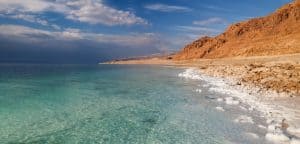
I chose to come back to Israel for a second time in one year, overriding my bucket list of roads not yet traveled. Some Americans I encounter are so quick to point out Israel’s weaknesses, while we live in a glass house of random acts of gun-toting violence and institutionalize racism. To that I say: Israel is a country like any other, yet like no other.
This was my fourth visit to the Dead Sea. I went first via tour bus, on the way to/from Masada, in 1982. Then I brought my sons and travel companions here for the day from Jerusalem, in 2012, thirty years later. Sometimes it takes me a few tries to appreciate a thing; I was convinced to give the Dead Sea another try this past December 2016, on the road from Jerusalem to Eilat. I thought I’d already been to the Dead Sea, but a day trip for tourists who mostly stop in a rocky place called Ein Gedi, and my newly beloved “beach” resort Ein Bokek, are two different things.
You descend to the Dead Sea. Signs on the road dramatically remind you how much above sea level you are, then you are at, then below sea level. Ein Bokek could be considered a Palm Springs of sorts, with high rise hotel properties which feature pools, spas, buffet restaurants, and nightly entertainment. What is decidedly nothing at all like Palm Springs, is that you are on THE Dead Sea, setting of many biblical stories. You are down the road from both Masada and Qumran, where the Dead Sea scrolls were stored, and you are less than two hours from Jerusalem, turning right (south) when you see signs to Jericho. If you keep going south, you’ll hit the Red Sea, talk about biblical sites. As the title of this essay hints, when you arrive in Ein Bokek, Facebook tells you that you’ve arrived in “S’dom,” which I thought nothing of until I passed a cliff that was somehow shaped like a woman and is fittingly named “Lot’s Wife.” It may not be the exact archeological site of Sodom and Gomorrah, both supposedly destroyed anyway, but it’s close enough.
The hotel rooms in the resorts all face the Dead Sea, the vista of which changes dramatically all day long. It’s all about the view, so I slept with the curtains open, to be awoken by the sun rising over the biblical Moab (modern Jordan) mountains – and I got my money’s worth. It was spectacularly unique, as pictured with this article. Ironically, I find it so peaceful here – yes, peaceful – perhaps there is no peace like peace in a country constantly beleaguered by lack of peace.
This time, my approach to the Dead Sea was a downward spiral from the city of Arad. I passed through Arad last in 1982, and I recall it to be a kind of outpost – a little roundabout with the name of the city posted on some rocks. I knew friends had studied there in college, so had been familiar with the name. Now, the city has grown to become a bedroom town, and many of the workers at the Dead Sea resorts commute from there. The city has grown over the past thirty years, thanks in part to the large wave of Russian immigrants following the fall of the Soviet Union in the early 1990’s. From the road you could see a sign for “Putin restaurant.”
There is actually a huge Russian subculture in Israel now. You can hear it in the media, see it in some of the faces, and taste it in the cuisine, but, interestingly enough, modern Israel was founded by people who came from parts of Russia and Eastern Europe anyway, so who knows or cares what is new Russian and what is old Russian. Another language other than Hebrew heard these days in Israel most frequently is French. France has been the site of the most violent anti-Jewish acts over this past decade, precipitating another wave of immigration to Israel. On the beach in Tel Aviv, we were surrounded by mostly Russian and French.
And I have a chilling premonition: I believe that in ten to fifteen years, maybe a little longer, there will be yet another newly prevalent language: English. There’ll be a new wave of emigration from – you got it – the United States. To be sure, there has been a steady immigration of Jews from the United States and all over the world for the past seventy years since the modern state of Israel began, but I see signs of trouble for Jews in America. I believe that the divisiveness that defines our current political climate is not good for Jews. The state of intolerance between the races not to mention ignorance about religion in the United States, is bound to make us victims again.
The main reason for this trip was that the Karmiel Dance Festival is held in August, when I can be away, instead of July, when I usually cannot. This happens once every five years, depending on when the particular holiday of Tisha B’Av (a fasting day which commemorates various catastrophic events in Jewish history) falls on the lunar calendar. Coming to Israel is always about dance for me, because my passion for Israeli dance is what brought me back to Israel in 2012 after decidedly not being so impressed with the place when I first came in 1982. Then, I’d chosen to live in Japan, and was still impressed enough with it. Now, I consider both Japan and Israel as second homes.
“Sunrise, Sunset” was a childhood theme song from Fiddler on the Roof; we sang songs from the show at the Jewish day camp I attended. Another unique detail about Israel is that you can see both sunrise and sunset, from sea to sea, in a single day.



Be the first to comment